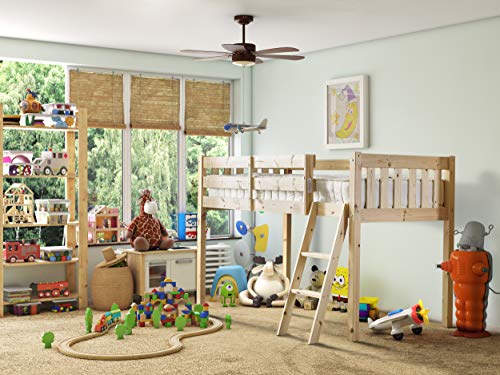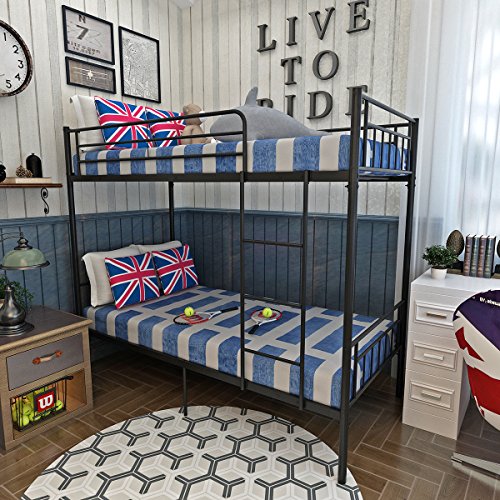20 Questions You Should Have To Ask About Bunk Bed For Kids Before You…
페이지 정보
작성자 Marquis 작성일24-08-18 19:34 조회16회 댓글0건관련링크
본문
 Choosing a Bunk Bed For Kids
Choosing a Bunk Bed For KidsA bunk bed can bring siblings closer and give them the feeling of adventure. It can also accommodate an extra twin or full mattress at the bottom for sleepovers.
If you are considering purchasing a bunk bed for your child, take into consideration these safety tips. Make sure that the staircase and ladder are secured to the frame, and that the gaps in the guard rails are not large enough for strangulation.
Safety
Bunk beds can be a fantastic space-saving option for children, but they can be risky if not properly set up and monitored. Always select bunk beds with full-length guardrails on both sides of the top bed. Also, you should look for beds that have been inspected by a third-party laboratory for safety and is in compliance with all CPSC guidelines. If possible, assemble the bunk bed in a room that has no windows or doors that can open to prevent children from escaping the bunks at nighttime.
When selecting a bunk bed, take into consideration the capacity for weight and the age range of your children. Some are designed for younger children only, whereas others are able to accommodate teens and even adults. Also, consider if you want the flexibility of having a trundle bed at the lower or to have just one twin mattress for both beds. Finally, if you're using the bed for more than two children Make sure that the beds are compatible and that you have enough space to comfortably accommodate both beds.
Some children are better at sleeping on the top bunk than others, and it's crucial to check their readiness for bunk beds on a regular basis. Experts advise that children under six years old do not sleep on the top bunk. They may lack the coordination or spatial awareness required to be able to safely climb the ladder.
Also, if your children often have friends sleeping over, make sure they know the rules of the bunk bed regarding the use of the ladder and no rough play or hanging from guardrails. Encourage your children to keep belts, jewelry and jump ropes off of the bunk bed. These can pose strangulation dangers. Some bunk beds are equipped with stairs instead of ladders which can provide peace of mind for children who are unable to climb. Lights for night can be put on bunk beds for kids to assist them in safely getting to and from the top bunk during the night.
Space-Saving
Bunk beds make the most of a small floor space by elevating sleeping areas, which frees space to play or study. While this solution is ideal for bedrooms for children, it can also add an impressive focal point to a living or dining area.
When selecting the right bunk bed for your children, consider your space's dimensions and their age. At around six or eight, they begin to show the maturity and dexterity that is required for a bunk bed. However, you know your children best and you should conduct an assessment of their ability to ensure they can manage the transition confidently and comfortably.
A lot of bunk bed designs include stairs or ladders that allow easy access to the upper levels. Stairs can take up more space than ladders, but they are safer for children as they learn how to navigate the beds' heights. Some bunk beds come with an inflatable slide that provides kids with the thrill every time they go to sleep.
If you decide to buy bunk bed a bunk with stairs, opt for a design that has plenty of storage options. This design from Lucy Harris Studio features a drawer beneath the stairs, which helps keep the bunks neat and organized.
Incorporate a theme in the design of your bunk beds to make them feel more special. For instance, a sporty bunk set is a great option for kids who are into soccer, baseball or football, while a bunk with a fairytale theme is perfect for little princesses. Bunks that have a desk integrated also offer a practical option for kids who need to do their homework or study at home.
Bunk beds are a great option for siblings who love spending time together but also respect their independence and privacy. When it comes to sleepovers for siblings the bunk beds allow the children to sleep comfortably without the need to use the sofa or floor. Only children sharing the same bedroom with their sibling are also able to have guests over for sleepovers.
Convenience
Bunk beds are a common choice for kids because they let siblings share a room, without taking up floor space. Children can play, learn and grow together while enjoying their independence. It is also easy for parents with an active family schedule to keep the house tidy and keep track of their busy schedule. Bunk bed designs are available in a variety of styles that make the most of vertical space. They can also be incorporated with any bedroom decor.
Bunk beds are a great way to reduce space and display your parenting style. Bunk and loft bed designs are available in a vast range of sizes and styles to suit any space, including twin over full-size beds and twin over queen beds. Some models come with built-in storage, while others provide additional storage space by using a twin or full trundle. These beds can be converted into two separate singles or a daybed when your children outgrow them.
In addition to saving you space, lofts and bunks can bring a sense excitement and excitement to any bedroom. Many children love the chance to claim the top bunk and turn it into a clubhouse, a fort, or even a pirate ship. They can invite their friends over to sleepovers and create a fun environment where they can engage in imaginative play.
Spending more time with their siblings during the night can aid in forming stronger bonds. No matter what age gap being able to keep each other company through the rough patches of siblinghood is a great way to strengthen ties and promote emotional development. Loft and bunk bed arrangements are great for older siblings that have younger siblings. The older child can be a mentor to the younger one and create a strong bond with them.
Ultimately, the right bunk bed for your kids depends on your child's ability to safely climb up and down. While the average child is ready to climb the top bunk about six years old, it's crucial to conduct a thorough assessment of your child's mental and physical development. The physical side of things includes whether they have the dexterity and coordination to navigate a ladder and bunk and the mental side of things considers their maturity and level of responsibility.
Style
 Bunk beds for children can add a fun, playful touch to any bedroom. They are great for friends or siblings who share a bed together. They also give kids the chance to show their personal style and personality through the decor, color and theme they choose for their room. When choosing a bunk bed, there are many options to consider.
Bunk beds for children can add a fun, playful touch to any bedroom. They are great for friends or siblings who share a bed together. They also give kids the chance to show their personal style and personality through the decor, color and theme they choose for their room. When choosing a bunk bed, there are many options to consider.A traditional bunk bed is the most basic configuration. It's two twin-sized bunk beds that are stacked one on top of the other. This configuration is ideal for siblings sharing a room, since it allows them to communicate easily even if they are on different floors. Many of the standard models of bunk beds offer customizable options that make it easy to find a bed that is suitable for the bedroom of any child.
Some bunk beds come with special features that make them more useful and fashionable. Some bunk beds include drawers under the bed to keep the space beneath the bunks organized and clean. It's easy to store bedding, clothes and other things. It's also possible to add curtains or drapes to the bunk beds to provide some privacy for sleeping.
Other types of bunk bed uk beds for children include loft beds that raise the mattress just a few feet off the floor. This configuration saves space and is a great place to study, read or just relax. You can also add more storage space by adding shelves or a desk.
The final option is to select the theme of your bunk bed so that it blends seamlessly into the overall theme of the room. Bunk beds for children can be designed to look like castles, trees or even pirate ships to add a touch of enjoyment to any room for children. These themed bunk beds encourage imaginative play and encourage creativity.
It's crucial to consider your child's maturity and age when deciding if bunk beds are the best choice for him or her. It is generally accepted that children should be moved to the top bunk at the age of 6 or 7. However, you'll be able to determine whether your child is at the age and capable of sleeping on higher furniture.
댓글목록
등록된 댓글이 없습니다.


